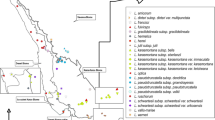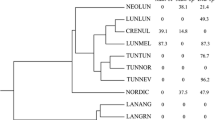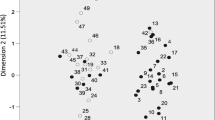Summary
A survey of allozyme polymorphism at 11 loci was carried out on 439 accessions from the genus Lens. This comprised 153 Lens culinaris subsp. orientalis, 35 L. odemensis, 117 L. ervoides, 32 L. nigricans, 2 of a differentiated cytotype of L. nigricans and 100 landrace accessions of the cultivated lentil (L. culinaris subsp. culinaris), from 10 different countries. The aim of the survey was to determine intra-specific genetic diversity and species relationships, based on phylogenetic and phenetic analyses, particularly regarding the position of L. odemensis and the differentiated cytotype of L. nigricans. Diversity was described by three statistics. The level of diversity in the cultivated taxon was lower than in any of the wild species according to two of these statistics, the percentage of polymorphic loci and mean number of alleles per locus. For the third measure (Nei's mean genetic diversity) it was only greater than L. ervoides. Genetic diversity statistics of the wild species indicated differences in the nature of between-population genetic diversity within the different taxa. Phylogenetic analysis suggests that L. odemensis and L. ervoides evolved from a common ancestor, and L. culinaris subsp. orientalis subsequently evolved from L. odemensis. Phenetic analysis, however, places L. odemensis closer to L. culinaris subsp. orientalis than to L. ervoides. Nei's mean genetic distance of L. odemensis from both L. culinaris subsp. culinaris (0.204) and L. culinaris subsp. orientalis (0.110) was greater than the distance between them (0.062). This evidence is not conclusive in determining whether L. odemensis should retain its specific status. Further crossability studies should be carried out on a range of genotypes to assess the potential for gene flow. The evidence presented shows the differentiated cytotype of L. nigricans to be quite distinct from other L. nigricans accessions, both phenetically and phylogenetically. This indicates that the differentiated cytotype of L. nigricans may constitute a new taxon. Discriminant function analysis reveals that isozymes may be useful in validating species classification.
Similar content being viewed by others
References
Abo-elwafaA., K.Murai & T.Shimada, 1995. Intra- and inter-specific variations in Lens revealed by RAPD markers. Theor Appl Genet 90: 335–340.
BarulinaH., 1930. Lentils of the USSR and other countries. Bulletin Applied Botany, Genetics and Plant Breeding, Supplement (English summary), 40: 225–238.
BhattyR.S., 1986. Protein subunits and amino acid composition of wild lentil. Phytochemistry 25: 641–644.
BrownA.D.H. & B.S.Weir, 1983. Measuring genetic variability in plant populations. In: S.D.Tanksley and T.J.Orton (Eds.) Isozymes in Plant Genetics and Breeding. Part A. pp. 219–239. Elsevier Science Publishers B.V., Amsterdam, The Netherlands.
CrawfordD.J., 1990. Plant Molecular Systematics: Macromolecular Approaches. John Wiley and Sons, New York, USA.
CuberoJ.I., 1981. Origin, Taxonomy and Domestication. In: C.Webb & G.C.Hawtin (Eds.), Lentils, pp. 15–38. Commonwealth Agricultural Bureaux, Slough, England.
de laRosaL. & N.Jouve, 1992. Genetic variation for isozyme gene and proteins in Spanish primitive cultivars and wild subspecies of Lens. Euphytica. 59: 181–189.
DoebleyJ., 1992. Molecular systematics and crop evolution. In: P.S.Soltis, P.S.Soltis & J.J.Doyle (Eds.), Molecular systematics of plants, pp. 202–222. Chapman and Hall, New York, USA.
HaveyM. & F.Muehlbauer, 1989a. Variability for restriction fragment lengths and phylogenies in lentil. Theor Appl Genet 77: 839–843.
HaveyM. & F.Muehlbauer, 1989b. Linkages between restriction fragment length, isozyme and morphological markers in lentil. Theor Appl Genet 77: 395–401.
HawtinG.C., F.J.Muehlbauer, A.E.Slinkard & K.B.Singh, 1988. Current status of cool season food legume crop improvement: an assessment of critical needs. In: R.J.Summerfield (Ed.), pp. 67–80. World Crops: Cool Season Food Legumes. Kluwer Academic Publishers, Dordrecht, The Netherlands.
HoffmanD., D.Soltis, F.Muehlbauer & G.Ladizinsky, 1986. Isozyme polymorphism in Lens (Leguminosae). Syst Bot 11: 392–402.
HoffmanD., F.J.Muehlbauer & G.Ladizinsky, 1988. Morphological variation in Lens (Leguminosae). Syst Bot 13: 87–96.
HubbyJ.I. & R.C.Lewontin, 1966. A molecular approach to the study of genetic heterozygosity in natural populations. I. The number of alleles at different loci in Drosophila pseudoobscura. Genetics 54: 577–594.
LadizinskyG., 1979a. The origin of lentil and its wild genepool. Euphytica 28: 179–187.
LadizinskyG., 1979b. Species relationships in the genus Lens as indicated by seed protein electrophoresis. Bot Gaz 140: 449–451.
LadizinskyG., 1986. A new Lens from the Middle East. Notes R Bot Gard Edin 43: 489–492.
LadizinskyG., 1993. Wild lentils. Crit Rev Plant Sci 12: 169–184.
LadizinskyG., D.Braun, D.Goshen & F.Muehlbauer, 1984. The biological species of the genus Lens. Bot Gaz 145: 253–261.
LadizinskyG., D.Braun & F.J.Muehlbauer, 1983. Evidence for the domestication of Lens nigricans (M. Bieb.) Godron in S. Europe. Bot J of the Linn Soc 87: 169–176.
LewontinR.C. & J.L.Hubby, 1966. A molecular approach to the study of genetic heterozygosity in natural populations II. Amount of variation and degree of heterozygosity in natural populations of Drosophila pseudoobscura. Genetics 54: 595–609.
MayerM.S. & P.S.Soltis, 1994. Chloroplast DNA phylogeny of Lens (Leguminosae): origin and diversity of the cultivated lentil. Theor Appl Genet 87: 773–781.
MuehlbauerF.J., N.F.Weeden & D.Hoffman, 1989. Inheritance and linkage relationships of several isozyme loci in lentil (Lens Miller). J Hered 80: 298–303.
MuenchD.G., A.E.Slinkard & G.J.Scoles, 1991. Determination of genetic variation and taxonomy in lentil (Lens Miller) species by chloroplast DNA polymorphism. Euphytica 56: 213–218.
NeiM., 1972. Genetic distance between populations. Am Nat 106: 283–292.
NeiM., 1973. Analysis of gene diversity in subdivided populations. Proc Natl Acad Sci USA 70: 3321–3323.
PinkasR., D.Zamir & G.Ladizinsky, 1985. Allozyme divergence and evolution in the genus Lens. Plant Syst Evol 151: 131–150.
RohlfF.J., 1993. NTSYS-pc Numerical Taxonomy and Multivariate Analysis System. Exeter Software, New York, USA.
SAS Institute Inc., 1988. SAS/STAT User's Guide, Release 6.03 Edition. Cary, NC:SASInstitute Inc. 1028pp.
SaitouN. & M.Nei, 1987. The neighbor-joining method: a new method for reconstructing phylogenetic trees. Mol Biol Evol 4:406–425.
Selander, R.K., M.H. Smith, S.Y. Yang, W.E. Johnson & B. Gentry, 1971. Biochemical polymorphism and biosystematics in the genus Peromyscus I. Variation in the old field mouse (Peromyscus polionotus), pp.49–90. University of Texas Publication 7103 Austin, Texas.
SharmaS.K., I.K.Dawson & R.Waugh, 1995. Relationships among cultivated and wild lentils revealed by RAPD analysis. Theor Appl Genet 91:647–654.
SolhM. & W.Erskine, 1981. Genetic Resources. In: C.Webb & G.C.Hawtin (Eds.), Lentils, pp. 53–67. Commonwealth Agricultural Bureau, Slough, England.
SoltisD.E., C.H.Hanfler, D.C.Darrow & G.J.Gaston, 1983. Starch gel electrophoresis of ferns: a compilation of grinding buffers, gel and electrode buffers and staining schedules. Am Fern J 73: 9–27.
TadmorY., D.Zamir & G.Ladizinsky, 1987. Genetic mapping of an ancient translocation in the genus Lens. Theor Appl Genet 73: 883–892.
TahirM., C.J.Simon & F.J.Muehlbauer, 1993. Gene map of lentil: a review. LENS Newsletter 20: 3–10.
VaillancourtR.E. & A.E.Slinkard, 1992. Inheritance of new genetic markers in lentil (Lens Miller). Euphytica 64: 227–236.
WeedenN.F., D.Zamir & Y.Tadmor, 1988. Applications of isozyme analysis in pulse crops. In: R.J.Summerfield (Ed.), pp. 979–989. World Crops: Cool Season Food Legumes. Kluwer Academic Publishers, Dordrecht, The Netherlands.
WilliamsJ.T., A.M.C.Sanchez & M.T.Jackson, 1974. Studies on lentils and their variation I. The taxonomy of the species. Society of Advanced Breeding Research in Asia and Oceania Journal (SABRAO) 6: 133–145.
ZamirD. & G.Ladizinsky, 1984. Genetics of allozyme variants and linkage groups in lentil. Euphytica 33: 329–336.
ZoharyD., 1972. The wild progenitor and the place of origin of the cultivated lentil, Lens culinaris. Econ Bot 26: 326–332.
Author information
Authors and Affiliations
Rights and permissions
About this article
Cite this article
Ferguson, M.E., Robertson, L.D. Genetic diversity and taxonomic relationships within the genus Lens as revealed by allozyme polymorphism. Euphytica 91, 163–172 (1996). https://doi.org/10.1007/BF00021066
Received:
Accepted:
Issue Date:
DOI: https://doi.org/10.1007/BF00021066




